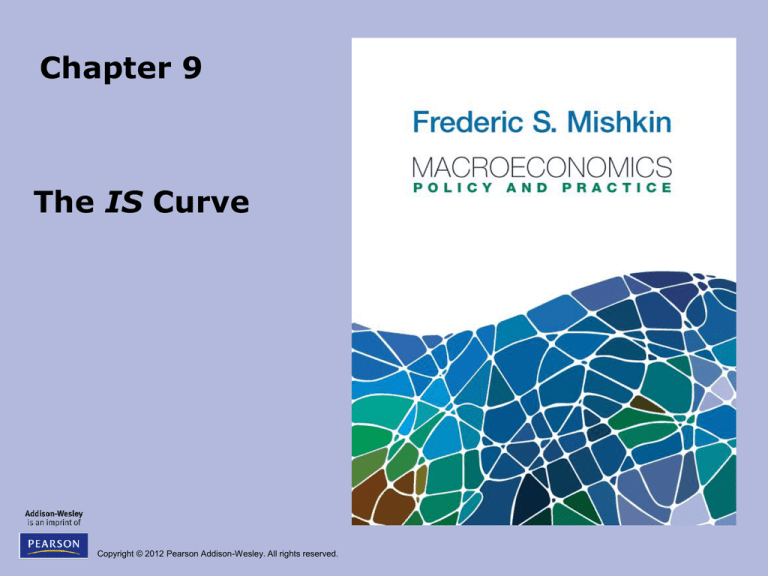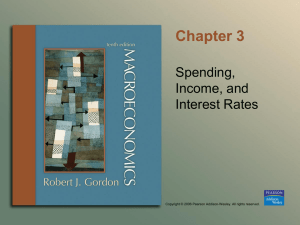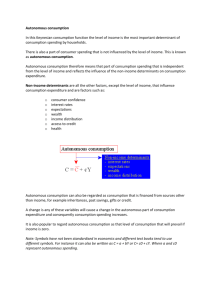
Chapter 9
The IS Curve
Copyright © 2012 Pearson Addison-Wesley. All rights reserved.
Preview
• To develop the IS curve as the first building
block to understand aggregate demand
• To examine factors that cause the IS curve
to shift
• To use the IS curve to discuss the economic
contraction during the Great Depression and
the effects of the fiscal stimulus package of
2009
Copyright © 2012 Pearson Addison-Wesley. All rights reserved.
9-2
Planned Expenditure
• Planned expenditure is the total amount
of spending on domestically produced
goods and services that households,
businesses, the government, and
foreigners want to make
• Planned expenditure is not the same as
actual expenditure, which is the amount
actually spent on
• Keynes viewed aggregate demand as
planned expenditure
Copyright © 2012 Pearson Addison-Wesley. All rights reserved.
9-3
Planned Expenditure (cont’d)
• Total planned expenditure (aggregate
demand) is:
Y pe C I G NX
where
C = consumption expenditure
I = planned investment spending
G = government purchases
NX = net exports (exports minus imports)
Copyright © 2012 Pearson Addison-Wesley. All rights reserved.
9-4
The Components of Expenditure
•
•
•
•
Consumption expenditure
Planned investment spending
Net exports
Government purchases and taxes
Copyright © 2012 Pearson Addison-Wesley. All rights reserved.
9-5
Consumption Expenditure
• Keynes viewed that consumer expenditure is
related to disposable income, YD, which is
total income minus taxes (Y – T)
• The consumption function
C C mpc (Y T )
where
C = autonomous consumption expenditure (exogenous)
mpc = marginal propensity to consume (the change in
consumption expenditure as a result of an additional
dollar of YD )
Copyright © 2012 Pearson Addison-Wesley. All rights reserved.
9-6
Consumption Expenditure
• Because consumption expenditure is
negatively related to the real interest rate,
r, the consumption function can be
modified as:
C C mpc (Y T ) cr
where
c = responsiveness of C to r
Copyright © 2012 Pearson Addison-Wesley. All rights reserved.
9-7
Planned Investment Spending
• Two types of investment:
1. Fixed investment—planned spending by firms
on equipment and structures and planned
spending on new residential housing
2. Inventory investment—spending by firms on
additional holdings of raw materials, parts, and
finished goods in a given time period
• Planned investment spending equals
planned fixed investment plus the amount
of inventory investment planned by firms
Copyright © 2012 Pearson Addison-Wesley. All rights reserved.
9-8
Planned Investment Spending
(cont’d)
• In the investment function, planned
investment is:
– negatively related to the real interest rate
– affected by business expectations about the
future (exogenous), as Keynes called “animal
spirits”
I I dr
where
I = autonomous investment
d = responsiveness of investment to the real
interest rate
Copyright © 2012 Pearson Addison-Wesley. All rights reserved.
9-9
Net Exports
• In the net export function, net export
includes:
– the level of net exports that are exogenous
– a component negatively related to the real interest
rate: A higher real interest rate raises the demand for
dollars and so its exchange rate (the price of the
currency), which in turn lowers net exports as exports
become more expensive for foreigners
NX NX xr
where
NX = autonomous net exports
x = responsiveness of net exports to the real
interest rate
Copyright © 2012 Pearson Addison-Wesley. All rights reserved.
9-10
Government Purchases and Taxes
• The government affects planned expenditure
through:
– Government purchases: assumed to be
exogenous at G
– Taxes: assumed to be exogenous at T
GG
T T
Copyright © 2012 Pearson Addison-Wesley. All rights reserved.
9-11
Goods Market Equilibrium
• Equilibrium in the economy occurs when the
total quantity of output produced equals the
total amount of planned expenditure:
Y Y
Copyright © 2012 Pearson Addison-Wesley. All rights reserved.
pe
9-12
Solving for Goods Market Equilibrium
• The equilibrium condition is:
Y C I G NX
• Substituting in the consumption, investment and net
export functions so that:
Y C mpc (Y T ) cr I dr G NX xr
C I G NX mpc T mpc Y (c d x)r
• The IS curve is obtained by subtracting mpc×Y from
both sides and divide both sides by 1-mpc:
Y [C I G NX mpc T ]
Copyright © 2012 Pearson Addison-Wesley. All rights reserved.
1
cdx
r
1 mpc 1 mpc
9-13
Deriving the IS Curve
• The IS curve shows the relationship
between aggregate output and the real
interest rate when the goods market is in
equilibrium
• The IS curve is made up of two terms:
1. The first term tells us about shifts in the IS
curve: Since mpc is between zero and one,
1/(1-mpc) >0, so this term tells us that a
change in autonomous variables affects output
at any given real interest rate.
2. The second term tells us about a movement
along the IS curve: A change in the real
interest rate affects output.
Copyright © 2012 Pearson Addison-Wesley. All rights reserved.
9-14
Understanding the Is Curve
• What the IS curve tell us: Intuition
– The IS curve is downward sloping because as
the real interest rate rises, planned expenditure
and aggregate output fall due to lower
consumption expenditure, planned investment
spending and net exports
Copyright © 2012 Pearson Addison-Wesley. All rights reserved.
9-15
Understanding the Is Curve
(cont’d)
• What the IS curve tell us: Numerical example
C $1.1 trillion, I $1.2 trillion, G $3.0 trillion
T $3.0 trillion, NX $1.3 trillion
mpc 0.6, c 0.1, d 0.2, x 0.1
• What is the IS curve?
Y =[1.1 1.2 3.0 1.3 0.6 3.0]
=
1
0.1 0.2 0.1
r
1 0.6
1 0.6
4.8 0.4
r 12 r
0.4 0.4
Copyright © 2012 Pearson Addison-Wesley. All rights reserved.
9-16
Why the Economy Heads Toward the
Equilibrium
• What happens if the economy is located at
the right of the IS curve?
– Actual output is above planned expenditure, so
that firms with unsold inventory will cut
production, moving aggregate output toward
the equilibrium level
Copyright © 2012 Pearson Addison-Wesley. All rights reserved.
9-17
Why the Economy Heads Toward the
Equilibrium (cont’d)
• What happens if the economy is located at
the left of the IS curve?
– Actual output is below planned expenditure, so
that firms with declining inventory will raise
production, moving aggregate output toward
the equilibrium level
Copyright © 2012 Pearson Addison-Wesley. All rights reserved.
9-18
FIGURE 9.1 The IS Curve
Copyright © 2012 Pearson Addison-Wesley. All rights reserved.
9-19
Why the IS Curve Has Its Name and Its
Relationship With the Saving-Investment
Diagram
• The goods market equilibrium of the IS curve is
equivalent to the equilibrium at which desired
investment, I, equals desired saving, S
• Assume G=0 and NX=0, then the goods market
equilibrium occurs when:
Y CI
• Subtracting C from both sides yields:
Y C I
• As Y-C equals saving:
Copyright © 2012 Pearson Addison-Wesley. All rights reserved.
SI
9-20
FIGURE 9.2 A Saving-Investment
Derivation of the IS Curve
Copyright © 2012 Pearson Addison-Wesley. All rights reserved.
9-21
Factors that Shift the IS Curve
• Changes in government purchases
– An increase in government purchases that
causes planned expenditure to rise also causes
equilibrium output to rise, thereby shifting the
IS curve to the right.
– Conversely, a decline in government purchases
causes planned expenditure to fall at any given
real interest rate and leads to a leftward shift of
the IS curve.
Copyright © 2012 Pearson Addison-Wesley. All rights reserved.
9-22
FIGURE 9.3 Shift in the IS Curve From an
Increase in Government Purchases
Copyright © 2012 Pearson Addison-Wesley. All rights reserved.
9-23
Application: Vietnam War Buildup,
1964-1969
• The United States’ involvement in the
Vietnam war began in the 1960s
• The resulting increases in military
expenditure raised government purchases,
which shifts the IS curve to the right
• With the real interest rate constant, the
increase in government purchases led to an
overheating economy
Copyright © 2012 Pearson Addison-Wesley. All rights reserved.
9-24
FIGURE 9.4 Vietnam War Build Up
Copyright © 2012 Pearson Addison-Wesley. All rights reserved.
9-25
Factors that Shift the IS Curve
(cont’d)
• Changes in Taxes
– At any given real interest rate, a rise in taxes
causes planned expenditure and hence
equilibrium output to fall, thereby shifting the IS
curve to the left.
– Conversely, a cut in taxes at any given real
interest rate increases disposable income and
causes planned expenditure and equilibrium
output to rise, shifting the IS curve to the right.
Copyright © 2012 Pearson Addison-Wesley. All rights reserved.
9-26
FIGURE 9.5 Shift in the IS Curve
From an Increase in Taxes
Copyright © 2012 Pearson Addison-Wesley. All rights reserved.
9-27
Policy and Practice: The Fiscal
Stimulus Package of 2009
• By the time the Obama administration took office
in January 2009, the U.S. economy was in crisis
• To stimulate the economy, the Obama
administration proposed a fiscal stimulus package
that included tax cuts and increased federal
spending and transfer payments
• This stimulus package was intended to raise
planned expenditure, thus shifting the IS curve to
the right
• The IS curve did not shift as right as hoped
because the effects of the fiscal stimulus was more
than offset by declines in consumption and
investment
Copyright © 2012 Pearson Addison-Wesley. All rights reserved.
9-28
Changes in Autonomous Spending
• Autonomous spending: exogenous
spending that is unrelated to variables in
the model
1. Autonomous consumption
2. Autonomous investment spending
Copyright © 2012 Pearson Addison-Wesley. All rights reserved.
9-29
Changes in Autonomous Spending
(cont’d)
• Autonomous spending: exogenous
spending that is unrelated to variables in
the model
1. Autonomous consumption
–
–
The resulting rise in autonomous consumption would
raise planned expenditure and equilibrium output at
any given interest rate, shifting the IS curve to the
right
Conversely, a decline in autonomous consumption
expenditure causes planned expenditure and
equilibrium output to fall, shifting the IS curve to the
left
2. Autonomous investment spending
Copyright © 2012 Pearson Addison-Wesley. All rights reserved.
9-30
Changes in Autonomous Spending
(cont’d)
• Autonomous spending: exogenous
spending that is unrelated to variables in
the model
1. Autonomous consumption
2. Autonomous investment spending
– An increase in autonomous spending therefore
increases equilibrium output at any given interest rate,
shifting the IS curve to the right
– One the other hand, the other hand, a decrease in
autonomous investment spending causes planned
expenditure and equilibrium output to fall, shifting the
IS curve to the left
Copyright © 2012 Pearson Addison-Wesley. All rights reserved.
9-31
Changes in Autonomous Net Exports
• An autonomous increase in net exports thus leads
to an increase in equilibrium output at any given
interest rate and shifts the IS curve to the right
• Conversely, an autonomous fall in net exports
causes planned expenditure and equilibrium output
to decline, shifting the IS curve to the left
Copyright © 2012 Pearson Addison-Wesley. All rights reserved.
9-32
TABLE 9.1 Shifts in the IS Curve From
Autonomous Changes in C , I , G, T , and NX
Copyright © 2012 Pearson Addison-Wesley. All rights reserved.
9-33









